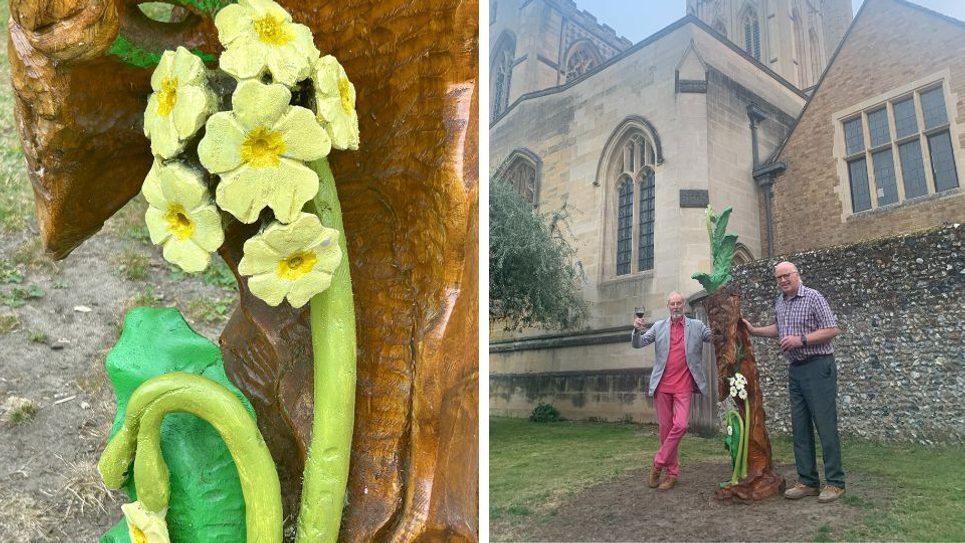
Back to Blogs
Discover
Discover Suffolk's County Flower - the Oxlip
The Oxlip - Suffolk's County Flower

The oxlip as seen in Bradfield Woods near Bury St Edmunds. Photo: Steve Alyward/Suffolk Wildlife Trust
The Oxlip, with its distinctive pale yellow blooms with five petals, is an ancient flower classed as near threatened in Britain and only grows in small parts of woodland in Suffolk, Cambridgeshire and Essex.
As an early flowering plant, oxlip provides nectar for early emerging bees and butterflies which will in turn pollinate the plant. It was voted the County Flower of Suffolk in 2002 following a poll by the wild plant conservation charity Plantlife.
Woodcarver John Williams has created a sculpture of an Oxlip in the Abbey Garden's to permanently symbolise this threatened Suffolk flower.
It has been expertly and lovingly carved from the stump of a cherry tree and shows a Green Man with the Oxlip in cupped hands, a nod to Nathaniel Hudson, who in 1831 founded the Abbey Gardens as a botanic garden.

As a young boy in the early 1950s John Williams watched an outdoor production of Shakespeare’s ‘A Midsummers night’s Dream’ in the Abbey Cloisters close to the carving. That evening the weather was good, a lovely summer’s evening, a sumptuous period production all of which took place beneath the huge canopy of a Copper Beech tree.
But really the opportunity to make this carving began in the 1940s when the tree was grafted and planted here. John must have arrived shortly after, as 7-year-old boy. He has known this cherry tree for most of his life and particularly it’s luxurious canopy of double pink blossoms in the Spring.
John had forgotten all about the play but now faced with bald tree stump, stark with its cluster of branches at the top, it began to resemble something of a comedy character, perhaps not unlike Bottom the weaver in 'a Midsummers Night’s Dream'.
John had never tried to carve flowers and didn’t even have an Oxlip to look at. He turned to Google search and found plenty of pictures, and took a screen shot to help with his design.
Now it is completed John can see in the tree what his minds-eye first imagined all those months ago. The folds of the leaves creating the face, the slim and weaving lines in the stems and even his smile in those once illusive oxlip flowers.
Did John unconsciously remember Oberon’s words from that 1950s summer night?
‘I know a bank where wild thyme blows
where the oxlips and nodding violet grows
Quite over-canopied with luscious woodbine
with sweet Musk-roses and with eglantine………………..’
If not the carving and words fit surprisingly well!
The Oxslip was painted by fellow volunteer and local resident Brian Jenkyn after the carving was complete.
The Abbey Garden Friends and West Suffolk Council supported the project, and many local residents and visitors have enjoyed watching the artwork develop.

Although the flower is rare, you can still find Oxlip blooming in woodland near Bury St Edmunds in April and May at Bull’s Wood Nature Reserve and Bradfield Woods Nature Reserve, run by Suffolk Wildlife Trust.
It can often be confused with cowslip, but they have deeper yellow flowers which don’t all face the same direction.
Did you know?
There is a rare mention of the Oxlip by Shakespeare in A Midsummer Night’s Dream, in which Oberon, King of the Fairies, is talking to his messenger Puck about where Queen Titania is sleeping:
“I know a bank where the wild thyme blows,
Where oxlips and the nodding violet grows…”
The common name "oxlip", from "ox" and "slip", may refer to the fact that oxlips (and cowslips) are often found in a boggy pasture used by cattle.
Oxlip was traditionally used to treat coughs and rheumatism.
Oxlip is a semi-evergreen perennial plant

The finished oxlip sculpture in the Abbey Gardens - carved from a cherry tree stump.
Related Blogs

News
Festive Winter Walks
Get outside and enjoy the fresh crisp winter air with…

News
Where to Go Pumpkin Picking…
Autumn fun, fresh air, and fields full of pumpkins in…

News
Bury St Edmunds Parks Awarded…
The stunning Abbey Gardens and Nowton Park have both…

News
Summer Walks
Make the most of the sunny days and warm evenings and…

News
Perfect Picnic Spots
With stunning countryside and gardens, there are many…
Latest news

News
Enjoy a Festive Afternoon Tea in 2025
Celebrate the Christmas season with a festive afternoon tea in Bury St Edmunds & Beyond...

News
Festive Winter Walks
Get outside and enjoy the fresh crisp winter air with one of these walks in Bury St Edmunds and Beyond!

News
Bury Tour Guides to launch new tours next year after successful 2025
Bury St Edmunds Tour Guides to Introduce new tours in 2026 and continue the successful Food and Drink Tours!

News
New in Bury St Edmunds For 2026
A sneak peak into new attractions visitors can enjoy in Bury St Edmunds in 2026.

News
Baby It's Cold Outside... Things To Do When the Weather Turns Frosty
Just because the temperature’s dropped doesn’t mean the fun has to! If you’re visiting town during the chillier months, there’s still plenty to see, do, and experience.

News
Places to sit by a roaring fire in Bury St Edmunds & Beyond
Warm up by a roaring fire this winter in Bury St Edmunds & Beyond...

News
Christmas Park and Walk 2025
Additional parking has been provided by West Suffolk Council in partnership with Greene King this Christmas.

News
Festive Theatre Guide 2025
There’s no better way to summon the magic of the festive season than a trip to the theatre.

News
Festive Markets in Bury St Edmunds
Festive markets are set to bring seasonal cheer to Bury St Edmunds this November and December, offering the perfect chance to pick up all of your Christmas essentials!
